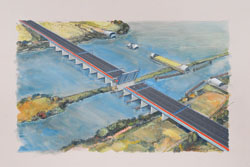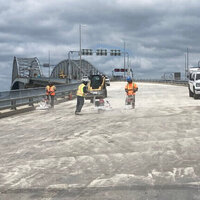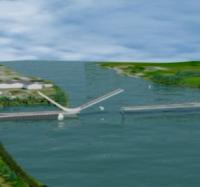Work is ongoing on the 216 stay cables to be installed on the USA side of the 2.5km-long bridge. It is currently taking two-to-five days to feed between 38 and 122 metal strands inside a weather-resistant, high-density polyethylene (HDPE) plastic pipe to make up each stay cable and stress it into position. Two parallel stay cable units are installed simultaneously and secured to steel boxes. Once the crane is moved into position and the structural steel and deck work is complete so that the stay cables are secured and tightened, crews move to the opposite end of the tower to install the next pair.
The 216 stay cables will be split in 108 pairs connecting each tower to the bridge and road deck. The cable pairs will be secured to 27 anchor boxes and 8 formwork boxes inside each tower and 108 edge girders on the deck. More than 16,000 metal strands will be used to connect the bridge towers to the deck. The bridge towers and cable system will be able to support weight of nearly 15.4 thousand t. The structure will also have no piers in the water.
The Canada-USA bridge is being delivered by the Windsor-Detroit Bridge Authority (WDBA) - a specially created not-for-profit, public-private partnership Canadian Crown corporation, responsible for overseeing and managing the construction and operation of the crossing. Bridging North America (BNA) is the private-sector partner to design, build, finance, operate and maintain the Gordie Howe International Bridge project. BNA is comprised of ACS Infrastructure, Fluor and Aecon, whose major projects include: the New Champlain Bridge Corridor in Montreal, Quebec; Réseau Express Métropolitain (REM) in Montreal, Quebec; Harbor Bridge, Corpus Christi, Texas; Tappan Zee Bridge in New York and the San Francisco-Oakland Bay Bridge, California.
According to the WDBA – the finished 2.5km crossing with a main span of 853m will be the longest cable-stayed bridge in North America and the 10th longest in the world. It is also expected to be among the five longest bridges in North America.
The completed Gordie Howe Bridge will carry six tolled lanes between Canada and the USA, three in each direction. One approach bridge on each side of the crossing will connect the ports of entry of each country. A dedicated multi-use path will accommodate pedestrians and cyclists. The Gordie Howe Bridge is currently projected to cost around US$4.2 billion.





